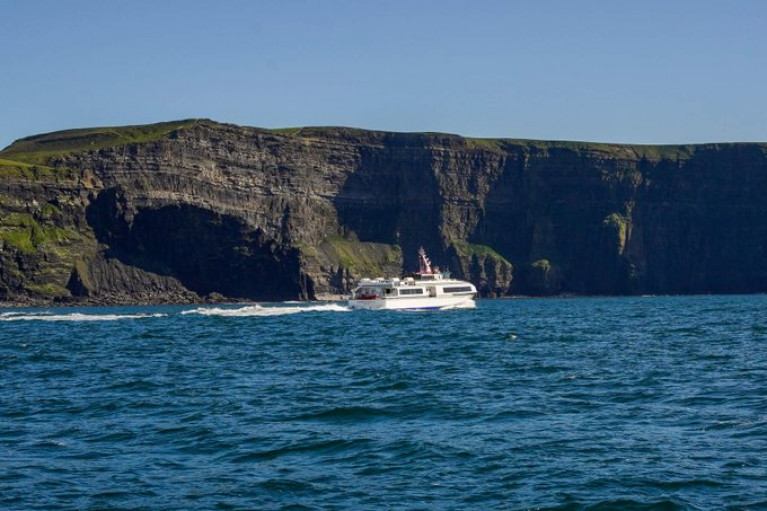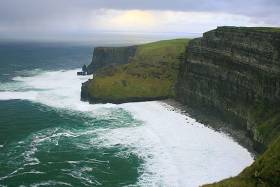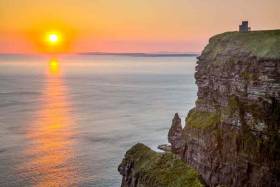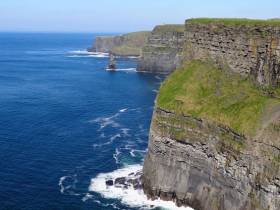Displaying items by tag: Cliffs of Moher
Developer Successful In Legal Challenge Over Cliffs of Moher Parking
A developer has succeeded in a legal challenge over parking at the Cliffs of Moher in Co Clare.
As The Sunday Independent reports, the Supreme Court has ruled against Clare County Council’s bid to be granted leave to appeal an earlier ruling in favour of developer John Flanagan.
Flanagan’s company, Diamrem Ltd, has built two park-and-ride facilities at Doolin and Liscannor.
The car parks were built under what Flanagan claims was a long-standing agreement with the council.
However, he says the continued use of a carpark next to the Cliffs of Moher has made his company’s facilities uneconomic.
It is understood he is seeking damages from the local authority. The newspaper reports the damages to be in the region of 15 million euros.
Read The Sunday Independent here
A seasonal gift from the Easter Bunny is for visitors to Galway this year, as Aran Island Ferries recommences its award winning cruise to Inis Mór and the Cliffs of Moher.
Last year saw the ferry company (added a new ferry) to its regular transport routes with a stunning day long, or even overnight trip to some of the most stunning locations in the west.
Setting off in the morning from Galway City, the tourist cruise of Galway Bay and beyond treats guests to the beautiful vistas of the west coast.
Awarded “Best Irish Experience 2021”, the cruise takes you to Inis Mór, the largest of the three Aran Island, to enjoy for several hours in the morning and afternoon.
The ferry will then return by way of the Cliffs of Moher, giving people a new way appreciate the staggering scale of Ireland’s most famous landmark, as the waterside wide truly puts the cliffs into perspective.
For further details of the ferry cruises, Galway Daily has more on the resumption of the service.
Cliffs of Moher is ‘Ireland’s Most Popular Selfie Spot’
The most popular location in Ireland for taking selfies is … the Cliffs of Moher.
That’s according to a new roundup of the 25 most popular selfie spots compiled by travel website EnjoyTravel.
The breathtaking North Clare coastal cliffs round out the list with a total of 634,375 Instagram selfies and 5,000,000 TikTok videos taken there, as RTÉ News reports.
That’s not far behind the numbers from such iconic sights as Rio’s Christ the Redeemer statue, Tokyo’s Shibuya Crossing, the Great Wall of China and the pyramids of Egypt.
But the news should come as little surprise to locals as the cliffs’ visitor centre regularly recorded more than a million visitors annually before the pandemic.
RTÉ News has more on the story HERE.
Appeal For Woman Reported Missing Near Cliffs Of Moher
A group searching for a woman missing near the Cliffs of Moher has contacted Afloat.ie in an appeal for her whereabouts.
Pauline Walsh was last seen on Tuesday 6 August in the Hag’s Head area in Co Clare, and since then family and friends have been searching the coastline from Black Head to below Doonbeg, the group says.
According to the Irish Mirror, the 54-year-old from Tullamore in Co Offaly is described as five feet seven inches in height, of a medium build, with blue eyes and short blonde hair.
When last seen she was wearing a pink fleece, black tracksuit bottoms and black runners with pink writing and trim.
Anyone sailing or fishing in the relevant areas of Co Clare and Galway Bay who might have any information about Pauline Walsh’s whereabouts is asked to contact the Garda at Tullamore or any Garda station, or call the confidential line at 1800 666 111.
Tragic Cliff Jumper’s Parachute Opened Wrong Way, Inquest Hears
#CliffsOfMoher - An inquest into the death of a BASE jumper at the Cliffs of Moher earlier this year has heard how his parachute opened in the wrong direction as he was in free fall from the top of the Co Clare beauty spot.
As previously reported on Afloat.ie, the deceased was one of three men who had gone to Aill Na Searrach to perform the jump on the morning of Saturday 22 April.
In his deposition at the inquest, as reported in The Irish Times, Greg McEntee said he completed his own jump and landing safely just before the late Malcolm Rowley leapt from the edge.
McEntee described witnessing Rowley’s free fall and saw him opening his parachute “but when it opened, it didn’t open facing away from the cliffs.”
The incident was a “one in a 100” chance, said the veteran skydiver and BASE jumper of the deceased, whom he noted as having “a reasonable amount” of experience.
BASE (building, antenna, span and earth) jumping is the practice of parachuting from low-altitude fixed objects or cliffs. The extreme sport is considered illegal in most circumstances.
The Irish Times has much more on the story HERE.
Cliffs of Moher Visitors Hit One Million for 2017
For the fourth year in a row, the Cliffs of Moher Visitor Experience in County Clare has recorded one million visitors within a calendar year.
The world-famous visitor attraction reached the figure today (Friday, 11 August 2017), 11 days ahead of the date the figure was reached in 2016 and exactly 10 weeks earlier than when the milestone was first reached in 2014. The North Clare visitor attraction is now on track to exceed its record visitor total of 1,427,166 people in 2016.
The Clare County Council owned attraction has undergone substantial investment in product and facilities in recent years while its position as a Signature Point along the 2,500km Wild Atlantic Way has contributed to its growing popularity.
While welcoming the continuing increase in popularity of the attraction, the Director of the Cliffs of Moher Visitor Experience says measures continue to be put in place to accommodate the increase in numbers sustainably.
“These significant visitor numbers are fantastic for the local tourism sector and the wider West of Ireland economy,” explained Katherine Webster.
She continued, “However, we continue to deal with the challenges in relation to capacity management and sustainable growth. Measures to sustainably manage group tour numbers have been in place for some time while long summer opening hours and advance notice of capacity constraints onsite are provided both online and via advanced digital signage on all approaches to the Cliffs.”
Ms. Webster continued, “The reality is much of the growth has been experienced in low and shoulder season while high season growth comes outside of the peak hours of 10.00 a.m. to 5.00 p.m. and the increased visitation in the evening drives benefitto accommodation in the local area. We also are working with other local tourism providers to encourage visitors to experience more of our wonderful county of Clarethan the Cliffs alone.”
Man Dies After Base Jump Gone Wrong At Cliffs Of Moher
#CliffsOfMoher - RTÉ News reports that a man died after a BASE jump went wrong at the Cliffs of Moher yesterday morning (Saturday 22 April).
It’s understood that the deceased, one of three men who had gone to Aill Na Searrach to perform the jump, fell onto rocks at the cliff base when his parachute did not open in time for a safe landing.
Good sea conditions meant the man was promptly recovered by the Irish Coast Guard helicopter Rescue 115, but he was later pronounced dead at Galway University Hospital.
The incident marks the second tragedy at the Cliffs of Moher this month, after a the body of a man seen falling near O’Brien’s Tower was recovered on 9 April, as previously reported on Afloat.ie.
Body Recovered After Cliffs Of Moher Fall Tragedy
#CliffsOfMoher - The body of what’s believed to be a young German man has been recovered from the Clare coast hours after he was seen falling from the Cliffs of Moher, as BreakingNews.ie reports.
Passers-by north of O’Brien’s Tower raised the alarm around 6.30pm on Saturday evening (8 April) but fading light and poor sea conditions delayed recovery by Irish Coast Guard volunteers till yesterday afternoon (Sunday 9 April).
Daring Burglary At Cliffs Of Moher Visitor Centre
#CliffsOfMoher - As much as €20,000 in cash is believed to have been taken in a sophisticated burglary at the Cliffs of Moher Visitor Centre yesterday morning (Monday 3 October).
According to The Irish Times, the building’s security system was disabled after the daring thieves cut its electricity supply, allowing them unfettered access to the visitor centre at one of Ireland’s leading tourist attractions.
Visitors were yesterday warned away from the Co Clare coastal beauty spot while ESB Networks technicians worked to restore power.
The Irish Times has more on the story HERE.
Divers Recover Body In Search For Missing Man At Cliffs Of Moher
#CliffsOfMoher - A body has been recovered from the sea below the Cliffs of Moher after a search operation that began on Wednesday (24 August).
BreakingNews.ie reports that the body was found last night but recovery by Garda divers could not be made till around this afternoon (Friday 26 August).
The man, believed to be in his late 50s and from Dublin, was reported missing earlier this week, with his car found near the popular Co Clare coastal beauty spot on Wednesday morning.





































































